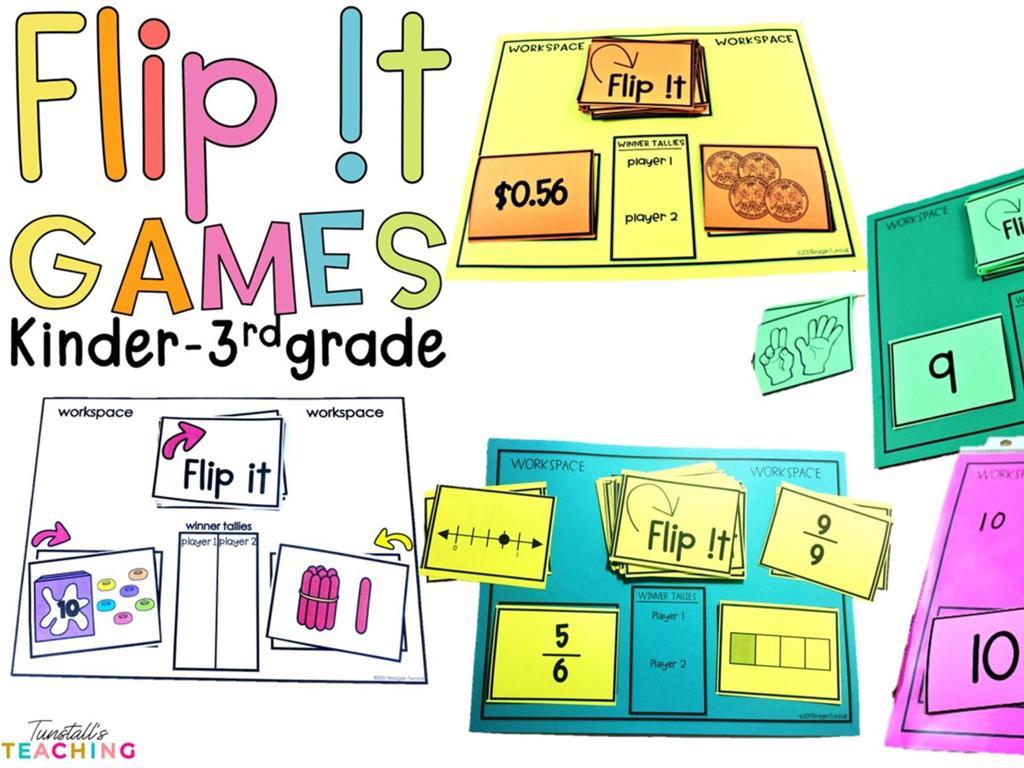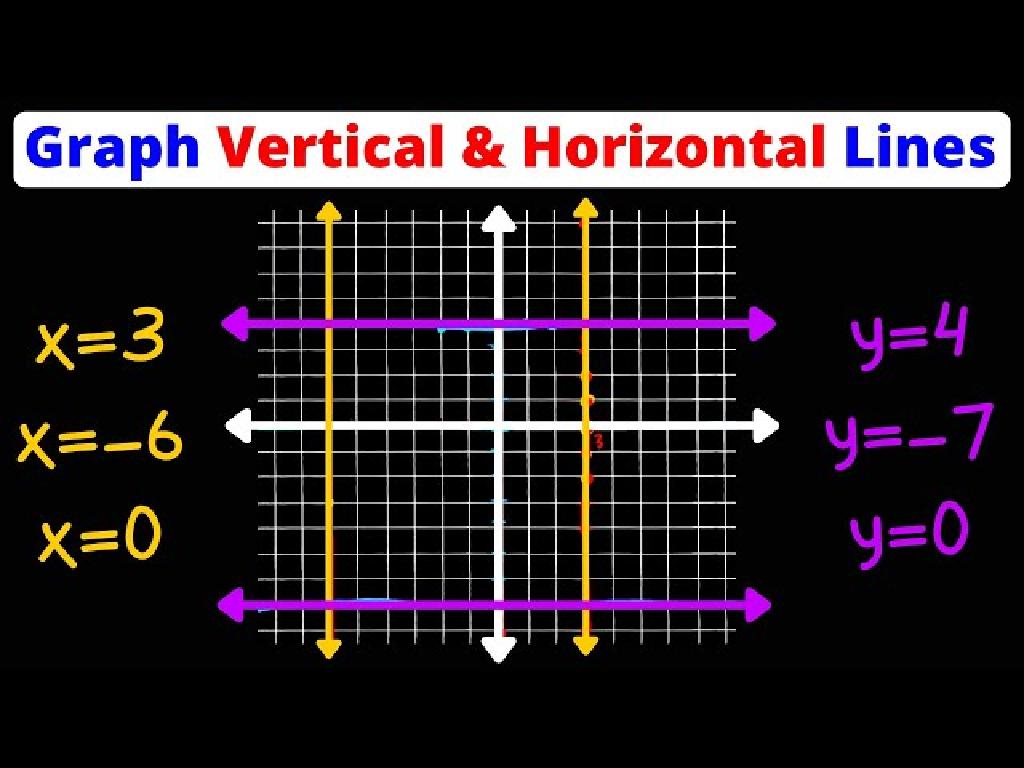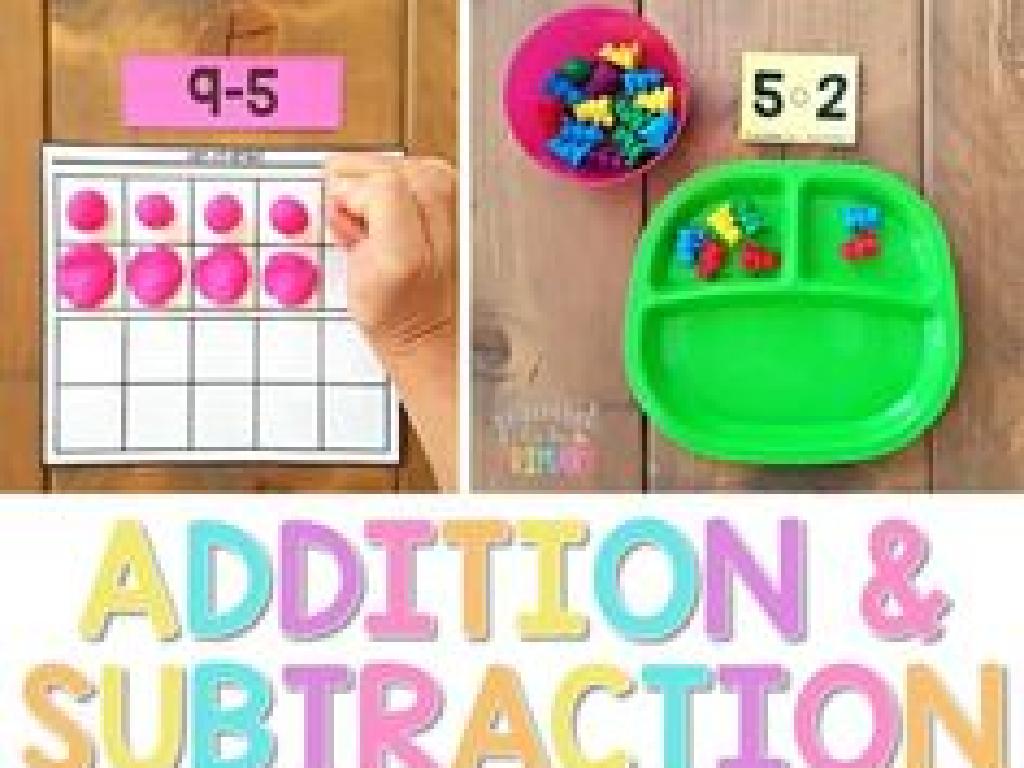Show Numbers On Frames - Up To 5
Subject: Math
Grade: Pre-k
Topic: Counting To 5
Summary: This engaging Pre-K math lesson introduces counting from 1 to 5 using fingers, objects, and visual number frames. Students explore each number individually with fun activities like clapping, jumping, and matching items, helping them connect quantity to numerals. Frames are used to visually represent numbers, making counting more concrete and interactive. Through hands-on games and collaborative exercises, children build early number sense and confidently recognize numbers up to 5 in everyday situations.
Please LOG IN to download the presentation. Access is available to registered users only.
View More Content
Welcome to Counting!
– Greet our little mathematicians
– Today’s focus: Learning about numbers
– Counting with our fingers
– Let’s count each finger, one by one
– Understanding numbers up to 5
– We’ll use frames to show numbers 1 through 5
|
This slide is designed to introduce Pre-K students to the concept of counting up to 5. Start the lesson with a warm greeting to make the children feel comfortable and excited about learning math. Explain that numbers are all around us and today we will focus on understanding them better. Use a hands-on approach by asking the children to show their fingers and count along with you, which helps them relate to the numbers in a tangible way. Introduce the concept of frames as a visual aid to represent numbers, which will be used to further illustrate how to count up to 5. This interactive method encourages participation and makes the learning process enjoyable for young learners.
What Are Numbers?
– Numbers show quantity
– Numbers tell us how many items we have
– Numbers are part of daily life
– We count toys, cookies, and even our fingers!
– Explore numbers 1 to 5
– Let’s count objects from 1 to 5 together
|
This slide introduces the concept of numbers to Pre-K students, emphasizing their role in quantifying objects. Start by explaining that numbers help us understand how many things we have, like counting apples in a basket. Highlight the everyday use of numbers, such as counting steps while walking or the number of blocks used in a tower. Then, focus on the numbers 1 to 5, using visual aids like number frames or counters to show each quantity. Encourage the children to participate by counting aloud and using their fingers to represent each number. The goal is to make them comfortable with recognizing and counting the first five numbers.
Learning the Number 1
– This is the number 1
– Use 1 for a single item
– Find one toy activity
– Can you spot one toy in our room?
– Number 1 is unique
– Just like you, there’s only one!
|
This slide introduces the concept of the number 1 to Pre-K students. Start by showing them the numeral and explaining that it represents a single item. Use concrete examples like one block or one apple to illustrate the concept. For the activity, ask the children to find exactly one toy in the classroom, which will help them associate the number with the quantity it represents. Emphasize that the number 1 is special because it signifies a single, unique item or individual, just like each of them is unique. This will help them remember the value of the number 1 and its importance in counting.
Learning the Number 2
– This is the number 2
– Number 2 for two items
– Like two apples, two toys
– Clap hands two times
– Let’s clap: one, two!
– Practice counting to 2
– Count one, then add one more
|
This slide introduces the concept of the number 2 to Pre-K students. Start by showing them the numeral ‘2’ and explaining that it represents the quantity of two items. Use tangible examples like two apples or two toys to illustrate this concept. Engage the students by having them clap their hands two times to physically experience the number. Finally, practice counting to 2, starting from one and adding one more, to reinforce their understanding. Encourage the children to find pairs of things around the classroom or at home to further solidify the concept.
Learning the Number 3
– This is the number 3
– Number 3 for three items
– Like 3 apples, 3 cars, or 3 crayons
– Touch your nose 3 times
– Let’s do it together: one, two, three!
– Practice counting to 3
– Try counting 1, 2, 3 with different objects
|
This slide introduces the number 3 to Pre-K students. Start by showing them the numeral 3 and explaining that it represents the quantity of three items. Use tangible examples like apples or crayons to illustrate this concept. Engage the students in a fun activity by asking them to touch their nose three times, counting out loud together to reinforce the concept. Encourage them to practice counting to three with various objects in the classroom or at home to solidify their understanding. The goal is to make them comfortable with recognizing and using the number 3 in different contexts.
Learning the Number 4
– This is the number 4
– It looks like a sail on a boat
– Four items count as 4
– Like 4 apples, 4 cars, or 4 blocks
– Let’s jump four times
– Jumping helps us remember the number
|
This slide introduces the number 4 to Pre-K students. Start by showing them the numeral 4 and explaining that it represents a quantity of four items. Use tangible examples like apples or toy cars to illustrate the concept. Engage the students in a physical activity by having them jump four times to reinforce the number’s value. This kinesthetic approach helps young learners to associate the concept of the number with an action, making it more memorable. Encourage the students to count out loud with each jump. After the activity, ask them to identify groups of four items in the classroom.
Learning the Number 5
– This is the number 5
– Counting five objects
– When we have five toys, blocks, or candies, we count 1, 2, 3, 4, 5.
– Show me five fingers
– Look at your hand, raise it and count each finger out loud.
– High five for counting!
– A high five is a fun way to show we’ve counted to five!
|
This slide introduces the number 5 to Pre-K students. Start by showing the numeral and saying it out loud. Then, help children understand the concept of five by counting out five physical objects, like blocks or crayons. Encourage the children to show their five fingers and count each one, reinforcing the number. Celebrate learning to count to five with a high five, making the learning process interactive and fun. This activity helps with number recognition and one-to-one correspondence in counting.
Numbers on Frames: Visual Counting
– Frames make numbers simple
– A frame organizes objects to count easily
– Fill frames with dots for numbers
– Each dot in a frame represents one unit
– Let’s fill the frames up to 5
– Practice by placing dots in frames for 1 to 5
|
This slide introduces the concept of using frames to visualize and count numbers up to 5, which is a foundational math skill for Pre-K students. A frame is a tool that helps children see numbers as a group of objects, making it easier to understand the concept of quantity. By filling the frame with dots, children can concretely see the number they are counting. Encourage the students to participate in filling the frames with dots, starting from 1 and going up to 5. This hands-on activity will help them grasp the idea of counting and associating the number with its quantity visually. Make sure to have physical frames and dots (or counters) ready for the next class to allow the children to engage in this activity.
Let’s Practice Counting with Frames
– Show numbers using frames
– Use blocks to fill frames
– Fill the frame for number 2
– Place 2 blocks in the frame
– Fill the frame for number 4
– Place 4 blocks in the frame
|
This slide is designed for a hands-on activity where Pre-K students will practice counting to 5 by using frames and blocks. Provide each student with a frame and a set of blocks. Demonstrate how to place blocks in the frame to represent numbers. Start with simpler tasks, such as filling the frame to show number 2, and gradually increase the difficulty by moving on to number 4. Encourage the students to count aloud as they place each block. This activity helps in developing number sense and understanding the concept of quantity. Possible variations of the activity could include using different colored blocks for each number, having students work in pairs, or asking them to fill in the frames in a sequence.
Frame Filling Fun!
– Play a game with frames and blocks
– Take turns filling the frame
– Show the number the teacher says
– Get ready for number fun!
|
This interactive class activity is designed to help Pre-K students understand and recognize numbers up to 5 using a hands-on approach. Provide each student with a frame that can hold up to 5 blocks. As you call out a number, each student will place the corresponding number of blocks into their frame. This visual and tactile method reinforces number recognition and counting skills. Be prepared with different colored blocks to make the activity more engaging. Possible variations of the activity could include asking students to fill in the frame to show one more or one less than the number you say, or having students work in pairs to fill each other’s frames. The goal is to create a fun learning environment where students can physically manipulate objects to understand the concept of numbers.





